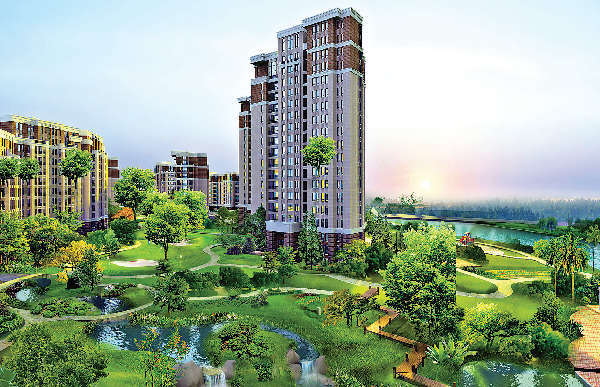Until now, neither the builders nor the buyers have cared much about the environment aspect of construction. But, today, it’s very possible to build environment friendly green buildings with materials sourced from Goa. Such buildings will help in protecting the environment for not only current generation, but also for future generations.

Are you aware that research shows that $1 saved in energy saves $12 in health and climate benefits? In simpler words, if we consume less energy, we will result in less pollution, which will help in improving the environment resulting in people having to spend lesser on their health.
Reckless construction over the years using lot of fossil fuels and energy has already caused enough harm to the environment around the world. People have made their lives comfortable today, but they have done so by mortgaging their own future and that of generations, which are going to come this planet. It's really high time that society moves towards green buildings to conserve the environment.
Bharat Kamat, co-chair, Indian Green Building Council (IGBC) Goa Chapter, said, "The idea behind green buildings is to control the impact of the structure on the environment. The first thing is to ensure that site selection is right. Then, materials used for construction should be environment friendly. For example, ready-mix-concrete (RMC) made under factory conditions is better than regular concrete."
Kamat continued, "Even the electrical fixtures and products in the building should be less energy consuming."
To get a green rating for a building, the developer must also ensure that all sorts of material for construction are bought within 400 kms radius of the project. Kamat further explained, "It's very possible to buy all materials required for construction within Goa. Godrej makes light weight blocks and pavers in Goa. Ion Exchange makes water treatment plants in Verna. Similarly, Finolex makes best cables in Goa."
But, there are builders, who are still sourcing materials from outside of the state. Such materials, when bought outside, have to be transported to the state, which requires fuel and is not environment friendly.
Kamat said, "We need to change our mind-set. When raw material for construction is made in Goa, there is no need to go out of state."
Kamat and KulaSekhar (designated partner, Milroc and also co-chair IGBC Goa Chapter) recently attended Green Building Congress at Jaipur. Both Kamat and KulaSekhar are of the opinion that constructing green building is not as expensive as it is perceived to be.
KulaSekhar said, "Earlier, green buildings used to cost a lot. But, now, the emphasis is to build green buildings by design itself, which will bring down cost. For example, have a design, which requires less cooling and therefore will result in lesser power bills. Instead of importing materials from far, builders can use local materials. It's possible to construct a building in Goa with material sourced from the state as well."
However, it is extremely important that the state government does hand-holding in this case by offering some incentives to developers for making green buildings. In Jaipur and Bangalore, the government gives extra floor-area-ratio (FAR) to builders for making green buildings.
Kamat said, "There is a proposal in Goa too, as per which, the state government will refund 25% of infrastructure tax paid to the builder, if the project has GRIHA rating. However, the government is yet to implement it."
GRIHA is India's national rating system for green buildings. Few builders have also recommended that buildings rated green by IGBC should be allowed to make use of this benefit. But, the government has not yet implemented this move.
There is a concern here, as the extra FAR will result in more construction, which can also harm the environment. Kamat explained, "When extra FAR is built on an existing structure, impact on environment is minimised. Therefore extra FAR does not affect environment adversely."
One could even ask as to why government should offer incentives for green buildings, if doing so results in loss of tax revenue.
Kamat replied, "A green rated building should have an organic waste composter and a sewage treatment plant (STP). This means that green buildings have to take care of their own waste rather than relying on government to create infrastructure. If more and more buildings become green, state government will not have to invest in building infrastructure like STP."
Take another example. A building can recycle its used water, which can be used for gardening or cleaning purposes. The idea is to ensure that fresh water is used only for bathing and drinking. Reducing water requirements will also mean that government will be able to control its spend on water infrastructure.
Even though the state government has a significant role to play in this area, but the responsibility is not of the government alone, as builders and buyers are equally responsible.
KulaSekhar said, "Vitrified tiles, which look glossy, require a lot of energy to make. Therefore, such
tiles don't get high ratings from green building viewpoint. Interestingly, there are tile manufacturers, who are going green, by reducing the amount of energy consumed in the manufacturing process."
Buyers and builders both need to be aware that materials like vitrified tiles aren't good for environment. And, there are better alternatives available in the market. Similarly, there are roof-coatings available, which prevent a structure from absorbing heat and thereby result in reducing power bills.
Goa is known as a green state, but the trend of green buildings is yet to catch up. Perhaps, the state government can consider leading the way by offering incentives for green buildings. If that happens, it will be a welcome change from environment viewpoint.